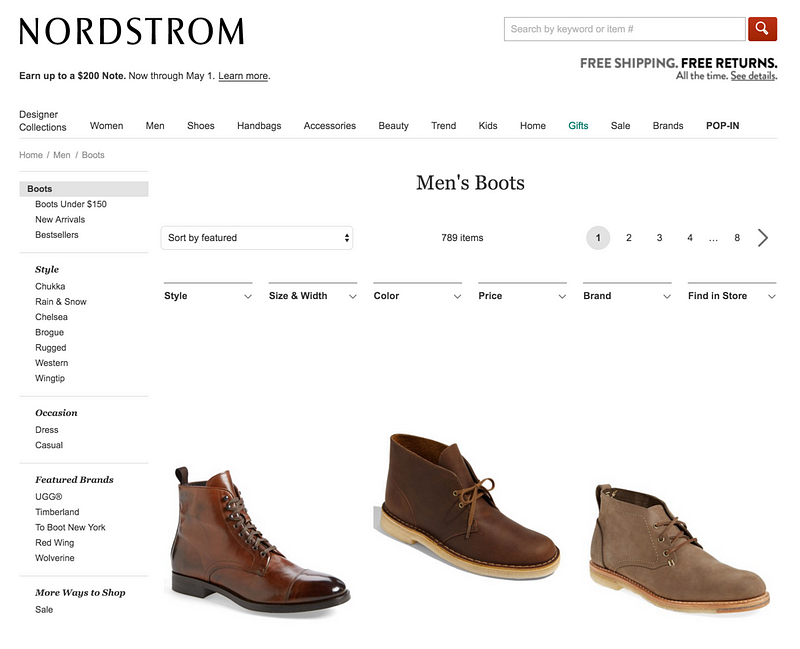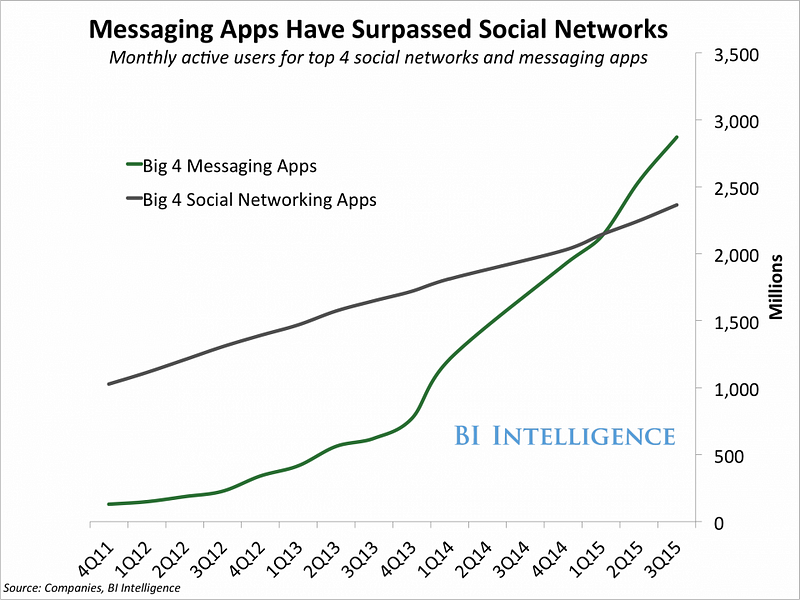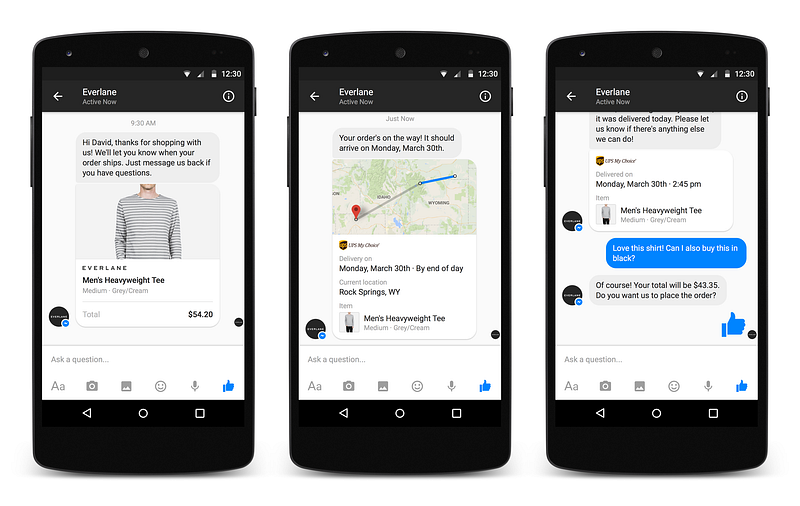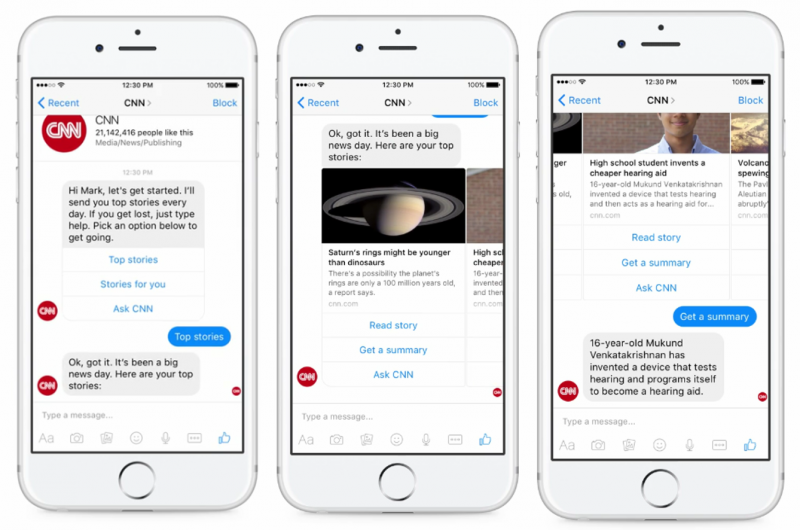Your one stop shop for best advice, tips, strategies on social media and digial marketing.
Monday, 16 July 2018
Friday, 6 July 2018
Thursday, 5 July 2018
Voice Search
You're in trouble! You haven't optimized your site for voice search.
— Angelina Cheng Matthews (@HighFlyrr) 5 July 2018
Neil Patel asks you to follow these 4 tips.#seo #digitalmarketing #internetmarketing #onlinemarketing #google #voicesearch #contentmarketing #alexa #mobiledevices #optimization https://t.co/vXvgrtgtSJ
Step to Step Guide to Launch an Online Business and Generate Passive Income Via Social Media
How to generate passive income via online business or social media? Here is a free webinar to show you step by step. Click below. https://t.co/Wv6Yn6wxZ3 #socialmediamarketing #passiveincome #onlinebusiness #entrepreneur #startup #AdviceforNewTwitterUsers #Fridaythoughts
— Angelina Cheng Matthews (@HighFlyrr) 5 July 2018
Saturday, 2 June 2018
The Complete Beginner’s Guide To Chatbots - Everything you need to know
What Is A Chatbot?
A chatbot is a service, powered by rules and sometimes artificial intelligence, that you interact with via a chat interface. The service could be any number of things, ranging from functional to fun, and it could live in any major chat product (Facebook Messenger, Slack, Telegram, Text Messages, etc.).
“Many businesses already have phone trees and they do work though most users get grumpy using them. Text based response trees are much easier and faster and that is what I expect a lot of early bot interactions to be. Sometimes with ability to chat with a live person.” — Josh Elman, Partner at Greylock
If you haven’t wrapped your head around it yet, don’t worry. Here’s an example to help you visualize a chatbot.
Example:
If you wanted to buy shoes from Nordstrom online, you would go to their website, look around until you find the shoes you wanted, and then you would purchase them.

If Nordstrom makes a bot, which I’m sure they will, you would simply be able to message Nordstrom on Facebook. It would ask you what you’re looking for and you would simply… tell it.
Instead of browsing a website, you will have a conversation with the Nordstrom bot, mirroring the type of experience you would get when you go into the retail store.

Facebook Showing Examples of Chat Bots
Watch this video from Facebook’s recent F8 conference (where they make their major announcements). At the 7:30 mark, David Marcus, the Vice President of Messaging Products at Facebook, explains what it looks like to buy shoes in a Facebook Messenger bot.
Examples of Chatbots
Buying shoes isn’t the only thing chatbots can be used for. Here are a couple of other examples:
Weather bot. Get the weather whenever you ask.
Grocery bot. Help me pick out and order groceries for the week.
News bot. Ask it to tell you when ever something interesting happens.
Life advice bot. I’ll tell it my problems and it helps me think of solutions.
Personal finance bot. It helps me manage my money better.
Scheduling bot. Get me a meeting with someone on the Messenger team at Facebook.
A bot that’s your friend. In China there is a bot called Xiaoice, built by Microsoft, that over 20 million people talk to.
See? With bots, the possibilities are endless. You can build anything imaginable, and I encourage you to do just that.

But why make a bot? Sure, it looks cool, it’s using some super advanced technology, but why should someone spend their time and energy on it?
It’s a huge opportunity. HUGE. Scroll down and I’ll explain.

Why Chatbots Are Such A Big Opportunity
You are probably wondering “Why does anyone care about chatbots? They look like simple text based services… what’s the big deal?”
Great question. I’ll tell you why people care about chatbots.
It’s because for the first time ever people are using messenger apps more than they are using social networks.

Let that sink in for a second.
People are using messenger apps more than they are using social networks.
“People are now spending more time in messaging apps than in social media and that is a huge turning point. Messaging apps are the platforms of the future and bots will be how their users access all sorts of services.” — Peter Rojas, Entrepreneur in Residence at Betaworks
So, logically, if you want to build a business online, you want to build where the people are. That place is now inside messenger apps.
“Major shifts on large platforms should be seen as an opportunities for distribution. That said, we need to be careful not to judge the very early prototypes too harshly as the platforms are far from complete. I believe Facebook’s recent launch is the beginning of a new application platform for micro application experiences. The fundamental idea is that customers will interact with just enough UI, whether conversational and/or widgets, to be delighted by a service/brand with immediate access to a rich profile and without the complexities of installing a native app, all fueled by mature advertising products. It’s potentially a massive opportunity.” — Aaron Batalion, Partner at Lightspeed Venture Partners
This is why chatbots are such a big deal. It’s potentially a huge business opportunity for anyone willing to jump headfirst and build something people want.

“There is hope that consumers will be keen on experimenting with bots to make things happen for them. It used to be like that in the mobile app world 4+ years ago. When somebody told you back then… ‘I have built an app for X’… You most likely would give it a try. Now, nobody does this. It is probably too late to build an app company as an indie developer. But with bots… consumers’ attention spans are hopefully going to be wide open/receptive again!” — Niko Bonatsos, Managing Director at General Catalyst
But, how do these bots work? How do they know how to talk to people and answer questions? Isn’t that artificial intelligence and isn’t that insanely hard to do?
Yes, you are correct, it is artificial intelligence, but it’s something that you can totally do yourself.
Let me explain.

How Chatbots Work
There are two types of chatbots, one functions based on a set of rules, and the other more advanced version uses machine learning.
What does this mean?
Chatbot that functions based on rules:
This bot is very very limited. It can only respond to very specific commands. If you say the wrong thing, it doesn’t know what you mean.
This bot is only as smart as it is programmed to be.
Chatbot that functions using machine learning:
This bot has an artificial brain AKA artificial intelligence. You don’t have to be ridiculously specific when you are talking to it. It understands language, not just commands.
This bot continuously gets smarter as it learns from conversations it has with people.
“Beware though, bots have the illusion of simplicity on the front end but there are many hurdles to overcome to create a great experience. So much work to be done. Analytics, flow optimization, keeping up with ever changing platforms that have no standard. For deeper integrations and real commerce like Assist powers, you have error checking, integrations to APIs, routing and escalation to live human support, understanding NLP, no back buttons, no home button, etc etc. We have to unlearn everything we learned the past 20 years to create an amazing experience in this new browser.” — Shane Mac, CEO of Assist
Bots are created with a purpose. A store will likely want to create a bot that helps you purchase something, where someone like Comcast might create a bot that can answer customer support questions.
“Messaging is where we spend a ton of our time and expect to communicate. It is ridiculous we still have to call most businesses.” — Josh Elman, Partner at Greylock

You start to interact with a chatbot by sending it a message. Click here to try sending a message to the CNN chatbot on Facebook.

Artificial Intelligence
So, if these bots use artificial intelligence to make them work well… isn’t that really hard to do? Don’t I need to be an expert at artificial intelligence to be able to build something that has artificial intelligence?

Short answer? No, you don’t have to be an expert at artificial intelligence to create an awesome chatbot that has artificial intelligence. Just make sure to not over promise on your application’s abilities. If you can’t make the product good with artificial intelligence right now, it might be best to not put it in yet.
“Everyone going after AI to try make this scale seems a little too soon. Texting to a computer that doesn’t understand many things you are saying can be very aggravating. So be careful early not to over promise, and give users guard rails” — Josh Elman, Partner at Greylock
However, over the past decade quite a bit of advancements have been made in the area of artificial intelligence, so much in fact that anyone who knows how to code can incorporate some level of artificial intelligence into their products.
How do you build artificial intelligence into your bot? Don’t worry, I’ve got you covered, I’ll tell you how to do it in the next section of this post.

How To Build Chatbots
Building a chatbot can sound daunting, but it’s totally doable. You’ll be creating an artificial intelligence powered chatting machine in no time (or, of course, you can always build a basic chat bot that doesn’t have a fancy AI brain and strictly follows rules).
“The difficulty in building a chatbot is less a technical one and more an issue of user experience. The most successful bots will be the ones that users want to come back to regularly and that provide consistent value.” — Matt Hartman, Director of Seed Investments at Betaworks
You will need to figure out what problem you are going to solve with your bot, choose which platform your bot will live on (Facebook, Slack, etc), set up a server to run your bot from, and choose which service you will use to build your bot.
“We believe that you don’t need to know how to program to build a bot, that’s what inspired us at Chatfuel a year ago when we started bot builder. We noticed bots becoming hyper-local, i.e. a bot for a soccer team to keep in touch with fans or a small art community bot. Bots are efficient and when you let anyone create them easily magic happens.” — Dmitrii Dumik, Founder of Chatfuel
Here are a ton of resources to get you started.
Platform documentation:
Facebook Messenger
Slack
Discord
Telegram
Kik
“It’s hard to balance that urge to just dogpile the latest thing when you’re feeling like there’s a land grab or gold rush about to happen all around you and that you might get left behind. But in the end quality wins out. Everyone will be better off if there’s laser focus on building great bot products that are meaningfully differentiated.” — Ryan Block, Cofounder of Begin.com
Other Resources:
How Bots Will Completely Kill Websites and Mobiles Apps by Matt Schlicht
Botlist, an app store for bots.
The Secret To Building Your Own Facebook Chat Bot In Less Than 15 Minutes by Jerry Wang
Go Library for Facebook Messenger Bots by Harrison Shoebridge
How To Build Bots For Facebook Messenger by Facebook
Building Your Messenger Bot [Video] by Facebook
Creating a Bot by Rob Ellis
Botwiki
Telegram Bot API — PHP SDK by Syed Irfaq
A Beginner’s Guide To Your First (Slack) Bot by Slack
Slackbot Tutorial by Michi Kono
Create A Slackbot Using Botkit by Altitude Labs
Sketch UI Kit For Messenger Bots by Mockuuups
How to create your own Telegram bot who answer its users, without coding by Chatfuel
Chatbots.org
Don’t want to build your own?
Contact me.
Now that you’ve got your chatbot and artificial intelligence resources, maybe it’s time you met other people who are also interested in chatbots.

How To Meet People Interested In Chatbots
Chatbots have been around for decades, but because of the recent advancements in artificial intelligence and machine learning, there is a big opportunity for people to create bots that are better, faster, and stronger.
If you’re reading this, you probably fall into one of these categories:
You want to learn how to build a chatbot.
You are currently building a chatbot or you have already built one.
You want to build a chatbot but you need someone else to help you.
You are researching chatbots to see if you and your team should build one.
You are an investor potentially interested in investing in chatbot startups.
Wouldn’t it be awesome if you had a place to meet, learn, and share information with other people interested in chatbots? Yeah, we thought so too.

That’s why I created a forum called “Chatbot News”, and it has quickly become the largest community related to Chatbots.
The members of the Chatbots group are investors who manage well over $2 billion in capital, employees at Facebook, Instagram, Fitbit, Nike, and Ycombinator companies, and hackers from around the world.
We would love if you joined. Click here to request an invite private chatbots community.
I have also created the Silicon Valley Chatbots Meetup, register here to be notified when we schedule our first event.
That’s all for now!
I wish you luck in your journey to create your own chatbot and to dive headfirst into the world of artificial intelligence (if you haven’t already). Join us in this private community if you want to talk more.
Do you have an ecommerce company? We launched Octane AI, and we can help you do it. Learn more here.
Want to chat about bots? Are you thinking of making a cool bot? Are you investing in bots? Do you want feedback on your bot? Send me a message now.
I promise it will be the real me that responds and not a bot.
Friday, 25 May 2018
GDPR Explained in 5 Minutes & Who Will Be Affected
#GDPR is relavant to you regardless whehttps://www.youtube.com/watch?v=2MOSlDJxE3Mre you are based if your customers are in the EU or you are a EU registered enterprise. I explained some key aspects in my own words. If you need to listent o a professional lawyer, here are 2 best GDPR Free webinars I recently came across. Worth watching:
http://bit.ly/GDPRPackSZ
http://bit.ly/AllUNeed4GDPR
#GDPR #FreeWebinar #FreeTraining #GDPRCompliance
Wednesday, 16 May 2018
Monday, 14 May 2018
Introduce GDPR Compliance Webinar and Templates by Top Data Protection L...
GDPR is coming in less than 10-days time. Is your business compliant? Businesses or organizations who fail to comply with the GDPR requirements face fines of up to €20,000,000 or 4% of the business’s annual global turnover—whichever is the greater of the two.
Even if the GDPR does not directly impact your company, it may still influence the way you deal with personal data. When the regulation rolls out in a few days, it will no doubt put forth a precedent for future data protection standards, so establishing a similar framework of compliance now would worth your effort, wouldn’t it?
If you want to hear from top data protection lawyer how to get compliant for GDPR, get GDPR compliance templates for your business and listen to mastermind Q&A, register for this webinar at http://bit.ly/AllUNeed4GDPR and get your templates NOW.
What’s in the Webinar?
- Getting GDPR Ready: the key things you need to look out for your business
- GDPR Ready Content Working templates: specific consent wording templates for your business; you just need to tailor make them to suit your business
- ICO registration made easy: video walk you through registration process with ICO
- GDP Ready Privacy Notice Templates: wording you can you use, and how to modify for your business
- Database handling email templates: what you needs to say when sending email to people to get consent
- Mastering GDPR For Companies and Clients Based Outside EU
- 10K mastermind GDPR Q&A
The GDPR Compliant Templates Worth £2999
This webinar with basic kits is now £67+ VAT
You also have option to upgrade:
- 1:1 with top data protection lawyer in the UK
- Live webinar training monthly on GDPR updates
- Live Q&A sessions delivered monthly
Saturday, 12 May 2018
THE SMALL BUSINESS IMPACT OF GDPR
On May 25th, 2018, the General Data Protection Regulation (GDPR) will come into effect across the EU, with global implications. Canadian organizations – from start-up to enterprise – that do business with the EU or have an online presence that markets to EU customers must ensure policies for managing EU-based personal data will be GDPR compliant.
While the GDPR is only applicable to EU residents, Canadians are knowledgeable about their privacy rights too, and cautious about the perceived threat of new technologies. According to the 2016 Survey of Canadians on Privacy prepared for the Office of the Privacy Commissioner of Canada, the vast majority of Canadians (92 percent) expressed some degree of concern about the protection of their privacy. In an age of virtually instantaneous information-sharing, protecting personal data is a priority for many people, regardless of the country in which they live.
Businesses large and small need to be prepared for the impact the GDPR will have on how they do business and exchange information with customers. However, a recent global survey by Commvault reveals that only a small percentage of organizations (12 per cent) believe they will be compliant with GDPR by the deadline.
With less than 30 days to go, here are ten everyday workplace activities that should be considered more carefully from May 25th onward.
Celebrating Office Birthdays
An individual’s date of birth is their own personal data. Under the GDPR, it cannot be shared without express consent by the individual. So it is worth checking that you have everyone’s permission to host a shared calendar of birthdays in the office.
Sending Greeting Cards
If you were planning to send holiday greeting cards to your customers, you might want to think twice. If the cards will include individuals’ home addresses, make sure to acquire consent of the individuals in advance. If you do not have express consent to contact each customer, a different legitimate basis must be established for each business communication you send. So, it may be for the courts to decide the business legitimacy of sending season’s greetings.
Sharing Baby Photos
Think carefully before sharing baby photos with international colleagues. Personal data can only be transferred internationally if the country has been designated by the EU as providing an adequate level of data protection or by complying with an approved certification mechanism such as the EU-US Privacy Shield. Of course, if the sharing of a baby photo is deemed a purely personal activity, then it can be argued to fall outside of the scope of the GDPR.
Catering for Allergies
Do you have colleagues with nut allergies? Or perhaps they have kosher or halal dietary requirements? Sorry to say but these are all classed as personal data. So, before you call a restaurant or caterer, make sure you have your colleague’s permission to share their personal information with others.
Sharing Resumes for a Second Opinion
Not sure about a potential candidate for a role in your organization? Keep in mind that a resume contains personal data before sharing it for a second opinion. Of course, you could argue that it would be reasonable to share a resume of an applicant with others in the company on a need-to-know basis. However, an easy way to get a second view of a resume is to make it anonymous, by removing the name, address, phone number and any other identifiable information. This is also becoming a growing trend among businesses as part of an approach to remove gender and race bias in recruitment.
Joining a Mailing List
Does your website registration form have a pre-ticked box for customers to receive marketing information from third parties? You might want to rethink that come May 25th. Under the GDPR, silence, pre-ticked boxes and inactivity will no longer suffice as consent. You may also want to read through your privacy terms online, as any request by a business for consent to use personal information must be intelligible and in clear, plain language.
Talking Politics at Work
Political opinions are part of a special category of personal information, and organizations cannot record or process data about this type of information. So, if you were planning a company webcast about a forthcoming election, it may be best practice for a speaker to preface any comments with the phrase “I expressly consent to share this information about my political opinions”.
Calling in Sick
Health information is also part of that special category of personal information. Therefore, if you need to call in sick one morning to address a medical condition, you can’t then return to your sickbed and hope that the message will be passed on unless you have expressly consented for that information to be shared with every person who needs to be told. Alternatively, an individual can personally share that information themselves.
Data Auditing
Under the GDPR, an organization needs to have a designated person responsible for data protection matters, and in some cases, a company may need to formally appoint a Data Protection Officer before carrying out any large-scale processing of personal data. The appointed individual would be responsible for raising awareness of data protection regulations in an organization, training staff and managing audits of data processes.
Managing Data Breaches
If your business suffers a data hack, you’ve got to think quickly about alerting people. Under the GDPR, if personal data is accidentally or unlawfully lost, destroyed, altered or damaged, it needs to be reported to the supervisory authority within 3 days. And it’s not just the relevant authority that needs to be notified, all individuals impacted need to be informed too if it is likely to result in financial loss, identity theft or fraud.
Friday, 11 May 2018
10 Steps to Preparing Your Business for the GDPR (General Data Protection Regulation)
by Susan Friesen
Even if Your Business is Not Located in the EU
The General Data Protection Regulation is a new set of rules amended to the current Data Projection Act that will soon be mandated for those businesses dealing with European consumers.
On May 25, 2018 the regulation insists on safeguarding the personal information of all citizens of European Union member states. While many businesses are already aligned with the specifications, it's important to make sure your business has everything covered.
This article takes a look at what you need to have in place in order to avoid being found in violation of the GDPR.
The truth is these new rules are aimed at large companies who deal in information as a source of revenue. Smaller businesses aren't likely to be penalized the 4% of worldwide gross or 20 million Euros that large corporations will if they're found in violation.
If you're worried about having a mountain of work ahead of you to prepare, you shouldn't be. If you're unsure if you will be affected look for these key signals:
1. You deal in information as a commodity;
2. You request user's data when they complete a purchase and use the data elsewhere or store it;
3. You deal with one or more European countries.
If the answer is no to both then you will be fine!
So what can you do just in case?
Here's 10 steps your business can take to be best prepared for the GDPR, even if you are not physically located in the EU.
1. If your website has an online form that incudes a pre-checked box giving permission to receive promotional emails from 3rd parties, this box now needs to be unchecked.
2. If your business conducts any form of list-building, ensure everyone on that list has given explicit permission to be in it. Under the Canadian PIPEDA, it was enough to have implied permission; however, if any EU residents are in your database, the rules are much more firm that provides subscribers with the right to obtain the information stored on them.
3. Make sure your entire staff is aware of the new rules. Circulate a memo to all personnel with a follow-up meeting where the points are reviewed. Asking a few questions to key players whose roles would be most affected by the new rules is a great way to ensure they're aware of what they need to do.
4. Audit all stored client/customer info and track where you got it from and where it's been used. Keep a record of every bit of info and who you may have passed it to at any time, and document the relationship and reasoning.
5. Update your privacy policy so it includes the reasoning for retaining any user data, how it is legally used, and how users can contact your business if they feel their user information is in any way being misused.
6. Have a clear method in place to address requests for erasing a user's data. Under the DPA, users already had certain rights but the GDPR takes it further with information rights pertaining to their data stored by your business.
The rights consist of:
• the right to be informed
• the right of access
• the right to rectification
• the right to erasure
• the right to restrict processing
• the right to data portability
• the right to object
• the right not to be subject to automated decision-making including profiling
You will need to be able to provide all this information in a clear and machine-readable format (not in hand writing).
7. Have a process in place for handing over large volumes of requests. Previously under the DPA businesses had 40 days to comply with a request. That has been shortened to one month. Any lawful request must be fulfilled though if there are a large number of requests and the suspected reasoning is to cause problems for your business then these requests can be contested legally.
8. Have your lawful reasoning for retaining user data or passing to others clearly stated for users and ensure the opt-in option is not pre-ticked or unclear. Users must have a clear understanding of why you want their data, what you do with it, and who you might share it with. And they must have the option to say no. This is separate from Terms and Conditions.
9. If your business deals with anyone under the age of 16 then you'll need a parent or guardian's permission to process any of the child's data. This is very important and strictly regulated but at the same time if you're not dealing in information as a commodity then you're likely not going to have to worry.
10. Have steps in place to address a data breach. In the event that user's data may be compromised you will need to have a way to let all affected users know what was compromised and when. Assigning someone internally the task of coordinating the response is a great idea.
Click here to register a webinar by top data protection lawyers. It will also give you template for your business: email, privacy notice, etc. Worth to check it out.
Click here to register a webinar by top data protection lawyers. It will also give you template for your business: email, privacy notice, etc. Worth to check it out.
And that's it! As you can see it's a big business problem and more so rooted in user protection in Europe where social networks have been cited as problematic and susceptible to foreign influence.
North America is not really affected much but the issue is still very newsworthy, which can make some small business owners nervous when they don't need to be. In saying that, this article from Small Business BC https://smallbusinessbc.ca/blog/the-small-business-impact-of-gdpr/ points out some seemingly harmless potential data breaches that could put you at risk of violation such as sending out greeting cards to customers living in the EU.
Susan Friesen, founder of the award-winning web development and digital marketing firm eVision Media, is a Web Specialist, Business & Marketing Consultant, and Social Media Advisor. She works with entrepreneurs who struggle with having the lack of knowledge, skill and support needed to create their online business presence.
Article Source: http://EzineArticles.com/9938974
Saturday, 5 May 2018
How To Get Paid When Shopping - With Proof of Money Earned
Get paid when shopping? It's real and with proof. Click http://bit.ly/QuidcoReward
How to Rank #1 on Google for the World's Most Competitive Keywords | Ran...
#1: Your content needs to be super-detailed and thorough
If it's not thorough, like pillar content.
What I mean by pillar content is, that one piece of content that pretty much explains everything out there under the sun for that one topic. You know what the number-one result for SEO is?
It's Moz; it's The Beginner's Guide to SEO.
It's long, and it discusses everything about SEO, from how to do it, what it's about, how it got started, every little thing and every tactic or formula that Google's looking at to rank a site.
Now, my content doesn't rank us high, but if you notice, the content on Neil Patel isn't as thorough.
And you don't have to be as thorough, but it just shows, the more detailed you are, the better off you're going to be in rankings.
#2: Your content needs to be beautiful
The better-designed and the more beautiful it is, the better-off you are. People don't like looking at ugly stuff.
I don't like looking at ugly web pages.
No one else does either. Make sure your stuff is really pretty.
#3: It has to load fast.
If it doesn't load fast, it's not gonna work for most people, especially on their mobile phones.
They're pulling out their mobile phone, they're like, oh, this is taking forever to load.
More than 50% of the people using Google are on their mobile phone or mobile device.
So make sure your site loads fast, and especially that webpage that you're trying to rank.
#4: After you do that, cross-link that post or that pillar page on every other page on your website.
If you go to Neil Patel and you go to any single blog post, you'll notice that I link to my SEO article.
It's providing more juice; it's telling Google, hey, I'm linking to this article on every single page for a reason.
It's important; I find it important, I want users to know it's important.
They're clicking on it; you should rank it high up as well.
#5
The next thing you need to do is use Ahrefs.
Go, type in your competitor URLs, and see who links to them. Hit up all of those people and ask them for a link.
For example, you can send them a short email saying,
"Hey John, I noticed you're linking to X, Y, and Z site. I have a similar article that came out, but mine covers one, two, and three that their article didn't. Feel free to check it out here, and if you like it, link to it. Cheers, Neil."
And leaving an email like that to other people leave to your competitors will cause more links back to you. If you send 100 of those, you should get roughly five people linking back to you.
If you don't get five linking back to you, that means the email you're sending is too irrelevant people that shouldn't be linking to you in the first place.
#6
The next thing you'll want to do is, be patient. You're not going to rank right away. That page, after it was put up, it took a year and a half before it popped onto the first page.
You have to be patient and continually update it, provide more value, make it prettier design.
But as long as you're keeping everything up-to-date and you're patient, eventually you'll notice that your rankings will climb.
Mine went from being in the top thousand to top hundred to page five, to page four, to three, to two, and eventually page one.
It was a slow, gradual build.
#7
And here's the last tip for you, and this is what most people don't tell you when it comes to ranking.
If you have two sites, General Motors and BMW, they both have a lot of links, they both have billions of dollars to spend on SEO and marketing. So how does Google know which one to rank higher for car-related terms?
It's brand-related.
If Google noticed that more people are searching for BMW over General Motors, what are they going to do?
They're going to start ranking BMW higher because they have a bigger brand.
Thursday, 3 May 2018
How to Increase Traffic to Your Blog
by Neil Patel
Increase Traffic to Your Blog Tip #1: The first thing that I have for you is you need to adjust your title tags. What you'll notice when you log into Google Search Console, it'll show your pages with the most amount of impressions and the least amount of clicks. Look for the posts that have less than a five percent click-through rate. Once you've figured out which posts have the less than five percent click-through rate, look for all the keywords, 'cause when you click on that link, it'll show you Google Search Console what keywords you're getting traffic for, and look for the keywords that you're ranking decent position for, and add those keywords within your title tag and meta description. By doing that one simple thing, what's going to happen? More people are going to keep clicking, and clicking, and clicking on your listings because when they're searching, your keyword is going to be in the title and meta description. Increase Traffic to Your Blog Tip #2: Another thing that you should end up doing, and this is the second tactic, is continually sharing your old blog posts over and over again. Once you write a blog post, especially if it's evergreen, it's not over. Why can't you keep re-tweeting it out? Why can't you end up putting in scheduling it out and buffer so that you're continually getting shared? Not just a week from now or a month from now, but years from now. Why can't you take your old articles and re-share them on Facebook? I do that all the time, and I use Open Graph, that's where you can change your meta descriptions just for social media, and you can do this in the Yoast SEO plugin, and by doing that, what ends up happening is, is I can keep changing the title of the post, still make it super relevant, and re-sharing it on Twitter and Facebook. Increase Traffic to Your Blog Tip #3: Now that you got those two tactics out of the way, I want to give you one last tactic that's a really easy way to drive more traffic to your blog post. It's content repurposing. You don't have to write more blog posts, but you could end up taking that content and creating videos on that same type of material and releasing it on YouTube and Facebook.
You could end up creating podcast episodes on that same kind of content and release it to iTunes. By doing these little things and repurposing your content, it goes out extra miles, right? It ends up getting more views. You're getting more juice out of every single article. Heck, we even take our same content and put the whole article on Linked In. By doing that, yeah, people aren't coming back to our site, but that content is generating more eyeballs, and people are like, oh, that's written by Neil, this is awesome. He keeps giving more amazing information. And yeah, those people aren't going to come back to your blog and leave a comment, but they will leave a comment on Linked In, and you could respond to them, interact with them, build that connection, and you can still generate business. Follow those three simple things, and you'll build more traffic to your blog posts without building any more links or writing more content. Best of luck, if you have questions about how to do this or if you're confused, leave a comment below. I'll respond and teach you how to do it step-by-step. If you liked the video, please share, subscribe, like, let other people know about it. The more people I can help, the happier I am, thank you for watching.
Increase Traffic to Your Blog Tip #1: The first thing that I have for you is you need to adjust your title tags. What you'll notice when you log into Google Search Console, it'll show your pages with the most amount of impressions and the least amount of clicks. Look for the posts that have less than a five percent click-through rate. Once you've figured out which posts have the less than five percent click-through rate, look for all the keywords, 'cause when you click on that link, it'll show you Google Search Console what keywords you're getting traffic for, and look for the keywords that you're ranking decent position for, and add those keywords within your title tag and meta description. By doing that one simple thing, what's going to happen? More people are going to keep clicking, and clicking, and clicking on your listings because when they're searching, your keyword is going to be in the title and meta description. Increase Traffic to Your Blog Tip #2: Another thing that you should end up doing, and this is the second tactic, is continually sharing your old blog posts over and over again. Once you write a blog post, especially if it's evergreen, it's not over. Why can't you keep re-tweeting it out? Why can't you end up putting in scheduling it out and buffer so that you're continually getting shared? Not just a week from now or a month from now, but years from now. Why can't you take your old articles and re-share them on Facebook? I do that all the time, and I use Open Graph, that's where you can change your meta descriptions just for social media, and you can do this in the Yoast SEO plugin, and by doing that, what ends up happening is, is I can keep changing the title of the post, still make it super relevant, and re-sharing it on Twitter and Facebook. Increase Traffic to Your Blog Tip #3: Now that you got those two tactics out of the way, I want to give you one last tactic that's a really easy way to drive more traffic to your blog post. It's content repurposing. You don't have to write more blog posts, but you could end up taking that content and creating videos on that same type of material and releasing it on YouTube and Facebook.
You could end up creating podcast episodes on that same kind of content and release it to iTunes. By doing these little things and repurposing your content, it goes out extra miles, right? It ends up getting more views. You're getting more juice out of every single article. Heck, we even take our same content and put the whole article on Linked In. By doing that, yeah, people aren't coming back to our site, but that content is generating more eyeballs, and people are like, oh, that's written by Neil, this is awesome. He keeps giving more amazing information. And yeah, those people aren't going to come back to your blog and leave a comment, but they will leave a comment on Linked In, and you could respond to them, interact with them, build that connection, and you can still generate business. Follow those three simple things, and you'll build more traffic to your blog posts without building any more links or writing more content. Best of luck, if you have questions about how to do this or if you're confused, leave a comment below. I'll respond and teach you how to do it step-by-step. If you liked the video, please share, subscribe, like, let other people know about it. The more people I can help, the happier I am, thank you for watching.
Wednesday, 2 May 2018
How I Support My Family Working from Home
Would you like to have the opportunity to work from home and be financially free?
Wednesday, 4 April 2018
Saturday, 31 March 2018
Check These 8 SEO Boxes Before Launching A New Site
Most marketers and businesses looking to start a website focus on design and design only.
They want it to impress people. Design should appeal to the masses and make headlines with its beauty.
But it doesn’t mean everything when it comes to driving real traffic and sales.
When launching a new site, you have a fresh chance to capture a ton of organic traffic.
But in a competitive field where SEO is the top priority for marketers, it’s paramount that you start off on the right foot.
Optimizing your website for organic traffic isn’t easy. And it can’t be ignored.
Make sure you check these eight SEO boxes before launching your new site, starting with improving site speed.
1. Speed is paramount to success
Speed is crucial for retaining visitors, and bounces will destroy your SEO. Most people fall short, though. So if your site is speedy, you’ll already be one step ahead of most businesses.
More than 70% of the pages recently analyzed by Google in a recent study took seven seconds to load content above the fold.
For content above and below the fold, it took a total of ten seconds.
On average, it takes most landing pages 22 seconds to fully load. But more than half of all mobile site visitors will leave a page if it takes more than three seconds to finish loading.
That’s a huge problem.
To make matters worse, as page load time increases from one to seven seconds, the changes of a mobile site visitor bouncing skyrockets to 113%.

The number of elements on a page, which can increase loading times, can also affect conversion rates.
As the amount of images, text, and titles on a page jumps from 400 to 6,000, the probability of a conversion occurring decreases by 95.6%.
Luckily, you can use Google’s test my site tool to increase speed.
Before you can make your web pages faster across all devices, you’ll have to enter your URL.

Once you have entered in your site’s address, click “Analyze.” Then, you’ll be able to view your page’s site speed score for mobile and desktop.

Just hit the “Desktop” or “Mobile” buttons to toggle your view.

If your score could be better, Google will provide you with actionable tips and suggestions to boost speeds.

If you aren’t putting mobile before desktop, you’d better start soon. Here’s why.
2. Mobile comes first
More people are accessing the web with a mobile device than ever before. People use mobile more often than desktop or tablet browsing around the world.

In the past, Google has indexed sites by the content on desktop versions. However, Google is about to start indexing and rating your pages based on mobile experiences instead.
If your site’s desktop and mobile experiences are similar, the switch probably won’t have a huge effect on your rankings.
As an example, below are both the desktop and mobile experience for the same page. Notice how the same exact content appears on both:

However, mobile-first indexing might cause you to rank lower if you have a site with different content across the mobile and desktop versions

When the switch to mobile-first occurs, Google will be using the mobile version on the right to index and rank the pages, which is missing a ton of the content on the left.
This is known as non-responsive design.
If you’re planning on using it, you may want to make some changes.
Mobile searches won’t just help with rankings. They also lead to more purchases.
At least 76% of people who search for an item on their smartphone visit the business within a day and 28% of those searches/visits end with a purchase.

You should also focus on improving your site’s overall mobile design. When your mobile site is easier to navigate, your conversion rates will be higher.
HubSpot tested this by switching to more straightforward layouts, which lead to a decrease in bounce rates by 27%.

This proves that there really are certain instances where you should “keep it simple, stupid.” Keep your menus, search options, links, and filters as easily accessible as possible.
Less is more. Especially when it comes to the payment input.
Who wants to spend a ton of time entering a 16-digit credit card number? No one. And what if a customer isn’t near their credit card when they’re ready to buy?
Make it easy for returning customers to make purchases with a “Swipe to buy” feature.
Amazon has introduced this to accompany the “Buy Now” button on their mobile app.

Wish also uses a “Slide to Pay” feature on their mobile application.

The ease of use will lead to more conversions because you’re literally making purchases as simple as one swipe for your customers.
Another great way to boost SEO is to create content before you launch.
3. Create content before launch (and post regularly after launching)
If you want to bring in organic traffic, you need to use content marketing.
One of the only ways to effectively target keywords is through your content. And blogging is the easiest, fastest way to do it.
Before your site goes live, stockpile content. Write dozens of articles targeting your top keywords before you push the site live.
Why? People want to see that your site is active and legit.
If you don’t have content, people won’t trust you or be able to find you in the first place.
HubSpot data shows that companies with over 16 blog posts every month get nearly 3.5X more traffic than companies that only publish zero to four monthly posts.

And as the number of blog posts a company has published overall increases, so doe inbound traffic.
Companies with more than 400 blog posts get about double the traffic as companies with just 301-400 posts.

Long-form content can rank you even higher. Aim for at least 1,900 – 2,000 words per post for best results.

Next, set up Google Analytics and Search Console so that you can track site analytics.
4. Set up Google Analytics and Search Console
Analytics are key to growth in SEO.
If you don’t know what’s happening with your site, you can’t fix it. And if you don’t know what’s working, you can’t make sure to do it on every page.
Understanding organic traffic and where your links are coming from is critical.
Once you’ve built your site, set up Google Analytics to track how people will use and find your page.
You can view which channels traffic is coming in from, the number of sessions, the percentage of channel sessions that contributed to the total, and more.

With this information, you can optimize your site for specific keywords, correct mistakes, and continue with the methods that are successful.
Installing it before you launch means that you’ll begin collecting data as soon as your site is live so that you can optimize it ASAP.
To install it, visit Google.com/Analytics and sign up with your Google account.
When you’ve configured your site, paste your unique Analytics tracking code onto it.
If you’ve built your site with WordPress, you can also add the code with the Google Analytics by MonsterInsights plugin.

Once you’ve set up Google Analytics, add your site to Google’s Search Console for more detailed reports.

You can view data like search traffic, who is linking to your page the most, what your most-linked content is, and how your data is being linked.
You can also view keyword information, search CTR for each keyword, total keyword impressions, and more.
To add your website to Google Search Console, head to Google.com/Webmasters.
You can start using Search Console right away if your site is already linked to a Google Analytics account.
Once your site begins ranking keywords and bringing in traffic, you’ll have all of the insights you need. Check it every week or so to find new SEO optimization opportunities.
If you haven’t thought about on-page SEO yet, now is the time.
5. Master on-page SEO
If you’re starting a new website, there’s no reason to wait until you need to run an SEO audit to optimize on-page SEO.
Pick one keyword for every page. It helps to start out with lower-volume keywords that you can drum up interest for over time.
Next, write title tags that will attract search engines. Every page of your site should have its own unique title tag. Include modifiers like “2018” or “best” to pick up different long tail searches.

Keep title tags shorter than 55 characters so that they don’t get cut off in search results.
Use short, sweet URLs when building pages that also include the target keyword. For example, use www.yourwebsite.com/target-keyword instead of www.yourwebsite.com/2334905.
If you want to boost click-through rates, always use meta descriptions. Keep them shorter than 160 characters so that the full description appears in search results.
You should also optimize for Google Image search results. Add images to your pages. Create customized graphics with Canva or Stencil and add them to blog posts.
You should include target keywords in image filenames. Add keyword-rich alt text to all of your images when you upload them.
Reduce bounce rates by making the topic of your pages clear. Add the target keywords to the first 100 words of your article. Utilize keywords in heading tags for an even bigger SEO boost.
Include at least two outbound links to bigger authority sites in every piece of content that you create.
Add internal links, as well. Include at least two or three internal links to other articles in every new piece you write.
It also helps to use social sharing buttons that provide quick social proof and make it easy for readers to share content on social platforms.
Make sure that social sharing buttons are easy to see, like the ones used by Search Engine Journal.
Use the DiggDigg WordPress plugin to add social sharing buttons in a pinch.
Finally, double-check your SEO once you’re live with the help of an SEO audit tool like SEOptimer.
Long-tail keywords can help you convert sales. Do some research before you launch to gain the upper hand over competitors.
6. Perform long-tail keyword research
Long-tail keywords are those longer keyword phrases that are ultra-specific to what you’re selling or talking about.
When customers use these, they already know exactly what they’re looking for. By using them, you’ll be targeting those that are already ready to buy, which means even more conversions.
In the past year, I’ve generated 173,336 qualified visitors just using long-tail keyword phrases. That’s an increase of 91%.
You can drum up the same success, too.
Finding long-tail keywords is easy with a tool like Moz Keyword Explorer. Enter a term or phrase to begin.
Focus on metrics like volume, difficulty, or share of organic clicks.
Collect your results and target the keywords that are high in volume and low in difficulty. These will yield the best results.
Moz will also give you different keyword suggestions related to whatever you search.
Next, focus on optimizing all of your landing pages for SEO.
7. SEO optimize your landing pages
A well-designed landing page can boost sales and lead generation.
The more landing pages your site has, the more opportunities you have to catch incoming search traffic.
But there aren’t many sites out there than use specific landing pages to capture users.
According to MarketingSherpa, 44% of clicks for B2B companies go to a homepage instead of a landing page.
Your homepage is extremely important, but it’s not always the best place to create a strong relationship with searchers.
Here’s an example from the Kissmetrics “Product” landing page.
The professional graphics, modern layout, and bold color theme take the page to a new level.
Then, as you scroll down, you’ll learn even more about the features of their services. A video accompanies each section of text.
The brand also has clear, noticeable CTAs on their pages.
If you still aren’t convinced about what a money maker landing pages can be, pay attention.
Conversion Rate Experts made Moz $1 million just from a single landing page and a couple of emails.
Businesses with over 40 landing pages get 500% more conversions.
But good landing pages don’t have to be limited to just one page. Look at this example from KlientBoost:
The landing page is interactive and draws visitors in by asking questions. First, you select your goals and list where you advertise.
The landing page then asks a series of questions, which also serve as the company’s pre-qualifying questions for finding new leads.
At the end of the questionnaire, you have to enter contact information to send your free proposal.
Some visitors may abandon the page at this point if they don’t want to be contacted, but the interested ones will go ahead and fill out the form.
This is a simple multi-page landing page that can help you gain thousands of new qualified leads every month.
Here’s how you can make sure that your landing page is optimized for SEO.
Find a long-tail keyword with the steps listed in number 6 and use it throughout your landing page.
Be sure to add title tags, additional keywords, and a meta tag description.
Make sure that the content on landing pages is useful. You have to include headlines that will keep readers engaged.
The goal of each sentence and headline is to get readers to the next line.
Once you’ve got a nice looking headline, complete an engaging secondary headline and some well-written copy.
It doesn’t hurt to add in a testimonial, a CTA, and CTA button, links, and images. Put all of this information above the fold if you can. You could even keep it all to one page.
To sum it all up, the key elements of high-quality landing pages are:
- An engaging headline that uses a targeted keyword
- A catchy secondary headline
- Engaging, useful, informative copy that uses supporting keywords
- A testimonial or other form of social proof
- An actionable CTA (to sign up for your service or product, download a lead magnet, etc.)
- A CTA button to accompany your CTA
- Inbound and outbound links to boost your landing page SERP results
- High-quality imagery
- No navigation (you don’t want users leaving the page!)
Finally, generate an XML sitemap.
8. Generate an XML Sitemap
What is an XML sitemap, exactly?
XML stands for “Extensible Markup Language.” To put it simply, it lists all of the URLs that make up a website.
Then, it maps out how the site is structured and what it includes.
Hence the name sitemap.
Search engines use crawlers to index your website and organize the information on it. That’s why you need a sitemap.
These crawlers can read tons of data about your page, but the map makes it easier for the crawler to do this efficiently and quickly. It acts as a “Table of Contents” for your pages.
Once the crawler does this, your site has a stronger chance of having improved rankings quickly.
Once it does this, your website has a stronger likelihood of improving its rank quickly.
When you create an XML sitemap, submit it to the search engine(s) of your choice so that they can crawl your pages quicker.
To build a sitemap online, you can use XML-Sitemaps.com. You can index a maximum of 500 pages for free with this tool, but you’ll have to pay a fee of $3.49 per month after that.
Once you’ve generated a sitemap, add your site to Bing Webmaster Tools and Google Webmaster Tools. This will allow these search engines to crawl the pages.
If you have a Google Account already, just sign up for Webmaster Tools and add your site to it.
Go to Optimization > Sitemaps and click “Add/Test Sitemap” to submit your sitemap.
Conclusion
Most businesses are worried about design when looking to launch a new site, which is important.
But it won’t drive the majority of your traffic and sales. That’s why you need to focus on SEO before your site even goes live.
Speed is the number one factor that can make or break your website. If it takes longer than three seconds for your pages to load, you’ll lose tons of traffic. AKA potential customers.
Use Google’s PageSpeed Insights tool to test your speed. Improve your site with the suggestions given by Google.
Next, focus on optimizing for mobile. Mobile-first indexing will look at the mobile version of your site instead of the desktop version when it comes to rankings.
Make sure that your mobile site is showcasing the same content as your desktop site.
Create tons of long-form content before you ever launch, and post regularly once you do. Create at least 16 blog posts per month that are between 1,900 and 2,000 words for the best results.
From here, set up Google Analytics and Search Console so that you can get a clear picture of the traffic that you’re about to get.
Run a complete SEO audit before your page launches. Add in title tags, meta descriptions, images, and more.
Do some long-tail keyword research and add long-tail keywords to your pages for maximum conversions.
If you haven’t considered your landing pages when optimizing SEO, you need to. Create multiple landing pages that will capture specific needs.
Use engaging headlines that feature targeted keywords, informative copy, social proof, CTAs, inbound and outbound links, and try to keep all of this information above the fold.
Finally, generate an XML sitemap and submit the map to Bing and Google Webmaster tools. This will make it easier for search engines to crawl and index your pages.
Which of these SEO boxes have you checked off of your list before launching?
Subscribe to:
Comments (Atom)


